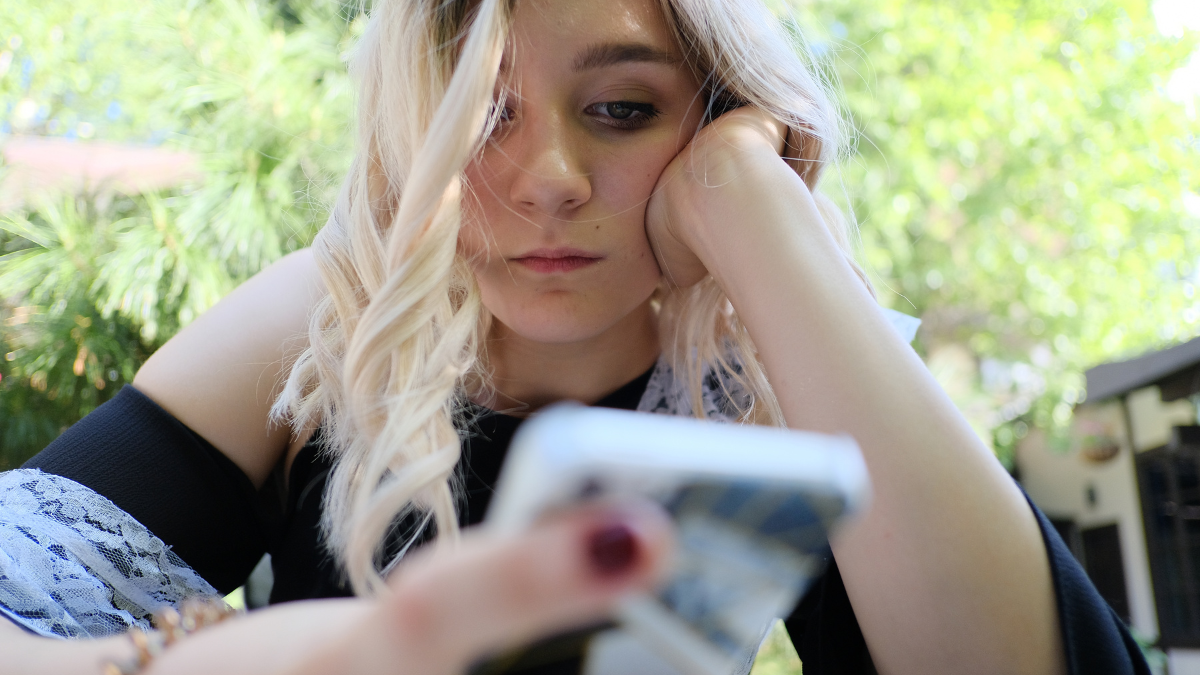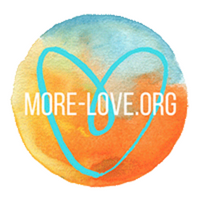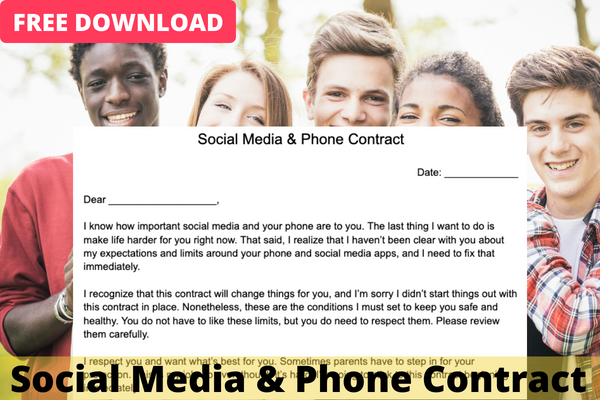
A new study found that TikTok videos focusing on “health” are dangerous for body image, promote weight loss, and may encourage eating disorders.
TikTok’s most-viral “health” videos overwhelmingly say that weight loss and thinness are achievable and desirable for all. TikTok is a major force in our kids’ lives, and it perpetuates harmful weight stigma and diet culture. It’s no surprise that the rise of social media coincides with the fact that eating disorders are skyrocketing.
Research has linked social media usage in adolescents and young adults to disordered eating and negative body image. This is most likely due to the prevalence of diet culture themes on social media, a primary source of information for many kids, teens, and young adults. Additionally, adolescent girls who report more time spent on social media are more likely to have high internalization of the thin ideal, a risk factor for eating disorders. TikTok is dangerous to kids’ body image and likely increases the risk of eating disorders.

Body Image Printable Worksheets
Colorful, fun, meaningful worksheets to improve body image!
- Boost confidence
- Improve self-esteem
- Increase media literacy
The dangers of TikTok
“Each day, millions of teens and young adults are being fed content on TikTok that paints a very unrealistic and inaccurate picture of food, nutrition, and health,” said Lizzy Pope, PhD, RD. Pope is an associate professor and director of the Didactic Program in Dietetics at UVM.
Kids, teens, and young adults who create and engage with weight or food-related content on TikTok are at higher risk of having internalized body image and disordered eating behaviors. TikTok’s viral weight loss content is a powerful megaphone for diet culture. TikTok videos spread common beliefs: 1) you should lose weight; and 2) you should eat less and move more to lose weight. However, the data shows that these beliefs are inaccurate and harmful. Also, they are the foundation of eating disorder beliefs and behaviors.
Eating disorders are pernicious and deadly. The last thing we need is a powerful social media app feeding our kids warped messages about health and wellness. But that’s what we’ve got. Here’s some more information for parents about TikTok and the risk it poses to body image and eating disorders. Keep reading for guidelines to protect your kids from the dangers of TikTok.
In interviews with NBC News, young women in their teens and 20s said that TikTok content has a significant and damaging impact on their relationship with diets and exercise. They said they became increasingly obsessed with their eating habits, workout routines, and weight to a dangerous degree. Meanwhile, eating disorders experts have been raising the alarm on the dangers of social media on body image for years.

What is TikTok?
TikTok went worldwide in 2018 and has been downloaded over two billion times globally. Most TikTok users are Gen-Z (born in the mid-1990s to mid-2010s). In July 2020, TikTok reported that one-third of its 49 million daily users were at or below the age of 14. This youthful market means that TikTok is an important driver of cultural trends.
TikTok is like Instagram or Twitter in that you can follow and like posts from specific accounts. But the app doesn’t require a person to follow certain accounts to view posts tailored to them. The default page for the app is a “for you” page with endless, algorithmically curated videos that the app has determined fit your preferences. Users report that the “for you” page on TikTok is eerie in its ability to create a crave-worthy feed that feels custom-made.
TikTok is driven by a powerful algorithm that learns a person’s likes and preferences. That means the more a person interacts with kitten and puppy content, the more kittens and puppies they will see. Similarly, the more they interact with diet culture and weight-stigmatizing content, the more of that they will see. This is why TikTok is so risky to kids’ body image and promotes eating disorders.
Pro-Ana content on TikTok
In fact, experts are deeply concerned about so-called “pro-ana” content being actively promoted on TikTok. Pro-ana is a colloquialism for “pro-anorexia,” and involves people who have anorexia competitively sharing tips and tricks for maintaining their disorders. Essentially, content that is coded as “healthy” is actually glorifying eating disorder behaviors by promoting severe food restriction, extreme weight loss, and rigid exercise programs.
“Content that supports or encourages eating disorders is strictly against our Community Guidelines and will be removed,” said a spokesperson for TikTok. However, eating disorders professionals have repeatedly complained that the algorithm sends disordered messages to people who have eating disorders.
TikTok and body dysmorphia
Body dysmorphic disorder (BDD), also known as body dysmorphia, is a severe psychiatric disorder that is strongly associated with depression, anxiety, eating disorders, and other serious mental illnesses. People with body dysmorphia have obsessive and compulsive thoughts about one or more perceived defects or flaws with their body.
Experts predict that between 5-10 million people in the United States have body dysmorphia. However, it’s likely the numbers are much higher given that it can be a difficult condition to diagnose and study. Because our culture has normalized the idea that people, especially women, hate their bodies and obsess about changing them, diagnosis outside of an eating disorder is uncommon.
Previously, mass media like magazines and television were accused of creating unrealistic body standards. But today using apps like TikTok is the greatest risk for body dysmorphia, negative body image, and eating disorders. It perpetuates harmful stereotypes about what is a “good” body and teaching eating disorder behaviors like extreme restriction, weight loss, and exercise programs in pursuit of the “perfect body.”
What is a hashtag?
Hashtags are a way that social media algorithms group similar content together. It’s the # symbol followed by a word or phrase. On TikTok, users can add hashtags to their captions to help the algorithm direct people to their content. Hashtags are a serious driver of the powerful TikTok algorithm, which is credited with its massive popularity among young people. However, hashtags and the algorithm are also why TikTok is especially dangerous when it comes to eating and body image. If someone starts liking content associated with weight stigma and diet culture, they will receive much more of that content.
The following data about TikTok is from this study: Weight-normative messaging predominates on TikTok—A qualitative content analysis, published November 1, 2022, in PLOS One
Glorification of weight loss
“The majority of posts presented a weight normative view of health, with less than 3% coded as weight-inclusive,”
Weight-normative messaging predominates on TikTok—A qualitative content analysis
Nearly 44% of all videos examined in the study had content about weight loss, and 20% showed a weight transformation in the video. A recurring theme is that if you just try hard enough, you can lose weight. These messages are often wrapped up with health claims that weight loss and low body weight are healthy.
The weightloss hashtag alone has almost 10 billion views at the time of the study. Many videos depicted weight loss transformation achieved through exercise routines and diet plans, often showing weigh-ins and clothing “downsizing.” Exercise was portrayed not for its many health benefits but for its potential to aid weight loss.
The videos use phrases like “no excuses,” “get up,” and “if you want it bad enough, you’ll do it.” This is a siren song for anyone with an eating disorder, cheering on the eating disorder behaviors and exacerbating the illness.

Body Image Printable Worksheets
Colorful, fun, meaningful worksheets to improve body image!
- Boost confidence
- Improve self-esteem
- Increase media literacy
Diets and fads
Thirty-eight percent of videos explicitly showed food (cooking, eating, getting take-out, etc.), and 11.9% of videos featured active cooking. However, there was a clear theme that food was seen as a way of pursuing health or wellness rather than something fun and enjoyable.
In 47% of videos with the hashtag “nutrition,” the video provided nutrition advice about what foods to eat. As expected, most offered advice about how to eat for weight loss. It was common for the video to pair a weight loss transformation with a “what they ate” sequence showing how they achieved their weight loss.
Diets were presented as a way to achieve a “body goal.” About 14% of videos mentioned a specific fad diet or dieting behaviors. The most popular fad diets on TikTok are:
- High-protein
- Low-calorie
- Liquid cleanses
- Intermittent fasting
- Weight loss or detox teas or drinks
Another popular trend on TikTok is to make “healthy” versions of “junk” food. This messaging perpetuates the myth that food carries the moral qualities of being either good or bad.
Who is creating viral body-toxic content?
“Most posts were created by white, female adolescents and young adults.”
Weight-normative messaging predominates on TikTok—A qualitative content analysis
The study found that 42% of the most popular posts were created by college-aged young adults, 28% by millennials and 11% were created by high school students. More than 64% of the videos were created by female presenting users and 56% by white-presenting individuals.
There was a notable lack of body diversity. Only 16% of posts showed someone with a larger body. This means the viral content on TikTok perpetuates the thin ideal, a major contributor to eating disorders.
Of all the videos about nutrition, just 1.4% were created by registered dietitians. This means that users are sharing nutrition tips with zero qualifications to do so.

TikTok guidelines for parents
TikTok is an important part of kids’ lives today. You can shut down all access to TikTok in the short term if you are currently dealing with an eating disorder crisis. However, over time you will want to support your child in learning to manage limits and manage social media since it’s likely to be an ongoing part of their life. Here are some guidelines for doing this:
1. Set social media expectations and limits
Your child will not like you setting social media expectations and limits. Of course not. But this is an essential safety issue. Explain to your child that you own their phone and can access or confiscate it anytime.
This feels harsh, but it is a required safety action that parents must take when a child is at risk. Just like requiring a seat belt in the car, you must insist upon social media oversight to keep your child safe.
Help your child understand that access to social media apps like TikTok is contingent on healthy consumption of TikTok. Let them know you’re going to monitor their use to ensure safety. You will need to do random checks of your child’s TikTok “for you” feed. The benefit of TikTok’s powerful algorithm is that your child can’t hide the type of content they are engaging with. If they engage with diet and weight loss content, their “for you” feed will be full of it. If they aren’t, it won’t.
2. Set up a phone contract
Some basic rules for phone use should be:
- You may not actively engage in diet and weight loss content or content that I believe is weight shaming and harmful. We’ll keep talking about this, so you understand what I mean.
- You’ll hand me your phone on request without protest as often as I ask. Failure to give me access to your phone will result in me confiscating it for hours, days, or a full week, depending on the situation.
- You will not turn off or change the parental controls I set. If you believe something should change, talk to me and gain permission. If you make changes without permission, I will confiscate your phone.
- I will open and review your apps, for example, to see what’s in your “for you” feed on TikTok.
- If I can see that you are unable to resist diet and weight loss content, I will remove TikTok and other social media apps from your phone indefinitely. If you add it back without permission, I will confiscate your phone.
- I will not open and read your DMs unless I am concerned.
- I will not open and read your text messages and emails unless I have reason to be concerned.
- The more I see that you are using social media in a healthy way, the less I will check, but it will never be never.
If you’d like a complete list of rules you can edit and present to your child, you can get it here.
3. Set up parental controls
You can set up the following parental controls.
- Set the account to private. Tap the menu icon in the upper-right corner of the profile and select Settings and Privacy, and choose Privacy. On the next screen, tap the button text to Private Account.
- Set a time limit. Set daily time limits on using TikTok, schedule mandatory breaks that lock your child out of the app, and see a summary of how much time was spent using the app.
- Filter keywords. Within settings, go to Content Preferences to set the app to block videos containing certain keywords. Tap Filter Video Keywords to add keywords and hashtags you want to be restricted. You can also choose which feeds to filter.
- Restricted mode. Within settings, go to Content Preferences to enable the password-protected Restricted Mode. This attempts to limit exposure to videos that the platform deems unsuitable for all ages. You can enable the mode by selecting it on the Content Preferences screen and setting a password so it can’t be easily disabled.
- Link your account to theirs. The Family Pairing feature allows you to link your TikTok account to your child’s for remote supervision and management. You can control who can send your child direct messages and who can comment on videos.
Note: you may also want to set parental controls on your child’s phone.
Hashtags to restrict/avoid on TikTok
- #thinspiration
- #fitspiration
- #cheatmeal
- #weightloss
- #quarantine15
- #diet
- #weightlossjourney
- #fatloss
- #weightlosscheck
- #whatieatinaday
4. Increase media literacy
A condition of using social media must be ongoing conversations about the risks and impact of social media. I suggest you talk about social media at least once per week. Ask your child questions like:
- Who do you follow?
- What do you see on your “for you” page?
- How do you feel when you look at diet and weight loss content?
- Do you think the people who go viral with diet and weight loss tips are credible sources of health information?
- Why do you think diet and weight loss content is so popular on TikTok?
- What do you think is the formula for a viral video on TikTok?
- How can you protect yourself from harmful content on TikTok?
- What is some TikTok content that you think is healthy? Why? How can you get more of that in your feed?
Participation in these conversations should be a condition of continued social media access.
5. Teach your child to tell TikTok not to show more diet and weight loss videos
The best thing your child can do is not engage with body and food content. But TikTok’s algorithm will likely continue to add diet and weight loss content to their “for you” page. Ask your child to actively select “not interested” when this content appears. This is how to do it:
I wish we could trust our kids to use social media safely, but that’s unrealistic. TikTok is dangerous to body image and increases the risk of eating disorders. It’s built on a compelling algorithm. And just like we don’t let kids jump in the car when they want to go somewhere without oversight and conditions, we can’t let them go on TikTok without safety measures to protect them.

Ginny Jones is the founder of More-Love.org, and a Parent Coach who helps parents who have kids with disordered eating and eating disorders. Combining science, compassion, and experience coaching hundreds of families, she helps parents understand what’s going on with their kids’ eating behaviors and teaches them the science-backed skills to heal kids’ relationship with food, improve their body image, and feel better about themselves, their relationships, and life in general.
Ginny has been researching and writing about eating disorders since 2016. She incorporates the principles of neurobiology and attachment parenting with a non-diet, Health At Every Size® approach to health and recovery.


